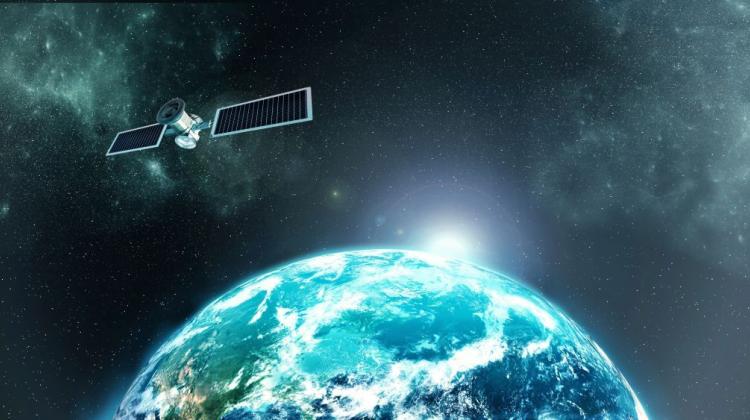Lemur will help clean up space

Lemur - robotic arm breadboard built by Polish scientists - like a perfect hand could catch large space debris from space, for example inactive satellites. In the future it may be useful to service the ISS, satellites and build orbital laboratories.
There are thousands of pieces of space debris in Earth orbit. They are formed, for example, as a result of unplanned collision of satellites moving on a similar trajectory. The collision of a Russian satellite with Iridium constellation satellite resulted in the formation of more than three thousand pieces. Some of the space debris are transport modules of rockets carrying objects into orbit, others - are already decommissioned satellites, and even items left in space by astronauts: a glove lost by astronaut Ed White and bags with real garbage from the Soviet station Mir.
Such useless satellites in orbit pose a threat to the orbital infrastructure - for example the missions monitoring Earth environment and space missions. "Even small pieces of space debris - on the order of 5 cm - fly at a speed of several kilometres per second. This is much faster than the speed of the bullet fired from a rifle, which means that they can easily damage other, working satellites. Large, out of control satellites pose an even greater threat" - said Dr. Karol Seweryn from the Space Research Centre PAS.
One of the largest pieces of space debris is the satellite Envisat decommissioned in 2009. Its removal is a very ambitious mission, because the object is 8 meters long and weighs 8 tons. In addition, it has a very complicated rotational movement, which complicates the capture manoeuvre. The European Space Agency plans to get rid of this troublesome satellite in 2022. There are a few ideas for its disposal.
One of them is to catch the satellite using a robotic arm mounted on a so-called service satellite. In practice, the entire operation would be as follows: satellite service approaches the space debris, recognizes its movement using optoelectronic systems, and then adjusts its relative position and orientation to ensure safe operation of the robotic arm. The final stage is the movement of the arm on a special trajectory for a safe grappling and subsequent stabilization of the object.
This manoeuvre is being prepared by an international team of scientists and engineers. The project is headed by the Spanish company GMV (with also a subsidiary in Warsaw), and the partners are the Italian company TSD as well as the Space Research Centre in Warsaw. The project named ORCO is carried out on behalf of the European Space Agency.
One of the most important elements of the project is Lemur - robotic arm breadboard developed by scientists from the Space Research Centre PAS. It will enable carrying out one of the core manoeuvres of the mission: catching the space debris. "Grapple mounted on the arm would catch the rim that was once used to attach the inactive satellite to the rocket that carried it into space. Once caught, the satellite can be rendered harmless" - told PAP the designer of the arm, Dr. Karol Seweryn from the Space Research Centre PAS.
Although this does not sound complicated, the entire project requires many simulations and extraordinary precision. "First we need to identify the object at a distance of many kilometres from us, to know how it moves and rotates in space. With this movement we must synchronize the movement of the satellite, which will approach the cosmic debris and catch it, minimizing the risk of collision. In the event of a collision, instead of helping we could contribute to creating more space debris. ORCO project pushes forward and advances in the major technologies involved in such complex task, including the Vision system and Image Processing to get knowledge of the debris object status, the Satellite control system along with the robotic arm (and the interaction among both). Working and testing in a space-representative dynamic facility with main HW (vision system, robotic arm, avionics processors, real motion) in the loop is also a big challenge" - head of the ORCO project Pablo Colmenarejo Matellano of GMV noted in an interview with PAP.
Scientists are dealing with, among other things, the interaction between the robotic arm and the satellite being removed. They are especially interested in the moment of contact between these objects. "Every time the robotic arm touches the target object, it produces specific forces and affects the second object" - explained the project leader. "Our robotic arm should be sufficiently stable to touch the defunct satellite for a few seconds without causing objects to repel each other. During that time the grapple could grab space junk" - added Dr. Seweryn.
Robotic arm could be used especially to catch larger objects, such as the Envisat satellite. "Using it to remove smaller objects does not make much sense. In that case a different solution would be better, for example a net" - suggested Dr. Seweryn.
"A net is a good system because it does not have to be so close to the target object, and there is no issue of synchronizing the movement of the satellite with the movement of space debris. The problem, however, it is that if the net catches and entangles a rotating space object, it starts to rotate with it. This process is difficult to control. It could be particularly dangerous in the case of catching a large object, for example Envisat, in the net. Robotic arm is more predictable and gives you much more control over the process of catching debris" - said Pablo Colmenarejo Matellano.
Lemur, on which Polish scientists are working, is a technology demonstrator. Should the European Space Agency decide to catch large space debris using this solution, there will already be a tested technology that can be developed with funds from national space agencies and ESA. In the future, Lemur could be used, for example, for maintenance of the International Space Station - ISS, telecommunication satellites, and to assemble and build orbital laboratories.
PAP - Science and Scholarship in Poland, Ewelina Krajczyńska
ekr/ zan/ mrt/
tr. RL
Przed dodaniem komentarza prosimy o zapoznanie z Regulaminem forum serwisu Nauka w Polsce.

















